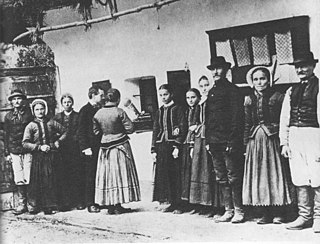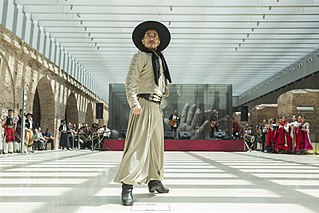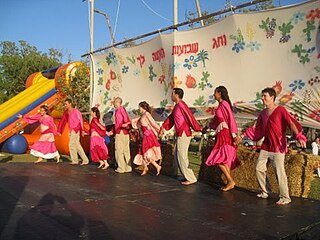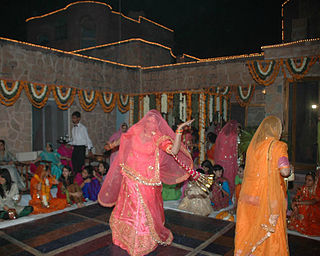Related Research Articles

Dance is a performing art form consisting of purposefully selected sequences of human movement. This movement has aesthetic and symbolic value, and is acknowledged as dance by performers and observers within a particular culture. Dance can be categorized and described by its choreography, by its repertoire of movements, or by its historical period or place of origin.

Folk music includes traditional folk music and the genre that evolved from it during the 20th-century folk revival. Some types of folk music may be called world music. Traditional folk music has been defined in several ways: as music transmitted orally, music with unknown composers, or music performed by custom over a long period of time. It has been contrasted with commercial and classical styles. The term originated in the 19th century, but folk music extends beyond that.

A folk dance is a dance developed by people that reflect the life of the people of a certain country or region. Not all ethnic dances are folk dances. For example, ritual dances or dances of ritual origin are not considered to be folk dances. Ritual dances are usually called "Religious dances" because of their purpose. The terms "ethnic" and "traditional" are used when it is required to emphasize the cultural roots of the dance. In this sense, nearly all folk dances are ethnic ones. If some dances, such as polka, cross ethnic boundaries and even cross the boundary between "folk" and "ballroom dance", ethnic differences are often considerable enough to mention.

The music of North Macedonia refers to all forms of music associated with North Macedonia. It share similarities with the music of neighbouring Balkan countries, yet it remains overall distinctive in its rhythm and sound.

In Southeastern Europe, the South Slavic people traditionally dance the circle dance, known as kolo, named after the circle formed by the dancers.

Raas or Dandiya Raas is the socio-religious folk dance originating from Indian state of Gujarat and popularly performed in the festival of Navaratri. The dance is performed in the Marwar region of Rajasthan too.

Israeli folk dancing is a form of dance usually performed to songs in Hebrew, or to other songs which have been popular in Israel, with dances choreographed for specific songs. Israeli dances include circle, partner and line dances. As almost all dances are intentionally choreographed, and the choreographers are known and attributed, the reference to these dances as "folk dances" is sometimes controversial among the general folk dance community. The recent trend of dances becoming much more complex and "professional" has led some to use the alternative term "Recreational Israeli Dancing".
Dance in Cambodia consists of three main categories: classical dance of the royal court, folk dance which portrays cultural traditions, and social dances performed in social gatherings.

Chhau dance, also spelled as Chau or Chhaau, is a semi classical Indian dance with martial, tribal and folk traditions, with origins in eastern India. It is found in three styles named after the location where they are performed, i.e. the Purulia Chau of Bengal, the Seraikella Chau of Jharkhand, and the Mayurbhanj Chau of Odisha.

Turkish folk dances are the folk dances of Turkey. Facing three seas, straddling important trade routes, Turkey has a complex, sophisticated culture, reflected in the variety of its dances. The dominant dance forms are types of line dance. There are many different types of folk dances performed in various ways in Turkey, and these reflect the cultural structure of each region. The Bar in Erzurum province, the Halay in the East and Southeast, the Hora in Thrace, the Horon in the Black Sea, Spoon dances in and around Konya and Lezginka in Kars and Ardahan are the best known examples of these.

Ghoomar is a traditional folk dance of Rajasthan. It was Bhil tribe who performed it to worship Goddess Sarasvati which was later embraced by other Rajasthani communities. The dance is chiefly performed by veiled women who wear flowing dresses called ghaghara. It was ranked 4th in the list of "Top 10 local dances around the world" in 2013. The dance typically involves performers pirouetting while moving in and out of a wide circle. The word ghoomna describes the twirling movement of the dancers and is the basis of the word ghoomar.
Ukrainian dance refers to the traditional folk dances of the peoples of Ukraine.

There are several styles of classical and folk dance in Sri Lanka.
Tamzara is an Armenian, Assyrian, Azerbaijani, and Greek folk dance native to Armenian Highlands. Tanzara means "half gilt, half decoration". The women dancing used to wear golden items including necklaces, beads, rings, ear-rings and other jewelry and those women expressed beauty and brightness. The name of Tanzara is related to this. This dance was especially popular in the regions of Erzincan, Erzurum, Kigi, Arapgir, Harput, and Malatya. There are many versions of Tamzara, with slightly different music and steps, coming from the various regions and old villages in the Armenian Highland.

Karnataka has a variety of traditional arts, including folk dance and puppetry.
Dutch folk dance are the traditional dances that were performed by the folk.
The traditional dances of Himachal Pradesh are varied and complicated. These dances are a vital part of tribal life. It reflects the culture and the tradition of Himachal. Hardly any festivity there is celebrated without dancing. Dance forms such as Nati are performed all over the region.
Folk dances of Sourashtra is a form of folk dance developed by a group of people, that reflects the traditional life of the people of a certain country or region. Folk dances no stringent rules, and sometimes formed among group of people. The steps of folk dance are passed through generations, rarely being changed. Sourashtra community people living in Tamil Nadu performing three folk dances in various occasions. The Gebbi or GebbEL, Konangi and DaNdi natana (kolaNe).

Arabic dances, also referred to as Oriental dances, and Eastern dances, are the traditional dances of the people of the Arab world. Arabic dances are very diverse and have many different styles, including the three main types of folklore, classical, and contemporary. It is enjoyed and implemented throughout the Arab region, from North Africa to the Middle East.
References
| This article about Indian dance is a stub. You can help Wikipedia by expanding it. |